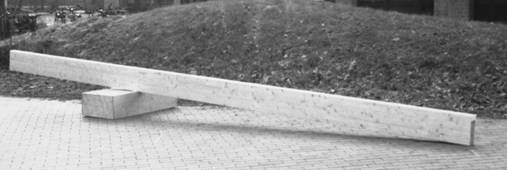 |
||||||||||||||||||||||||||||||||||||||||||||||||||||||||||||||||||||||||||||||||||||||||||
|
|
|||||||||||||||||||||||||||||||||||||||||||||||||||||||||||||||||||||||||||||||||||||||||
| The “Fall” of Bodies | ||||
| Galileo’s inclined plane experiments | ||||
| Galileo’s inclined plane experiments | ||||
In 1638, Galileo published a detailed description of one of his best known experiments. A piece of wooden moulding or scantling, about 12 cubits long, half a cubit wide, and three finger-breadths thick, was taken; on its edge was cut a channel a little more than one finger in breadth; having made this groove very straight, smooth, and polished, and having lined it with parchment, also as smooth and polished as possible, we rolled along it a hard, smooth, and very round bronze ball. Having placed this board in a sloping position, by raising one end some one or two cubits above the other, we rolled the ball, as I was just saying, along the channel, noting, in a manner presently to be described, the time required to make the descent. We repeated this experiment more than once in order to measure the time with an accuracy such that the deviation between two observations never exceeded one-tenth of a pulse-beat. Having performed this operation and having assured ourselves of its reliability, we now rolled the ball only one-quarter the length of the channel; and having measured the time of its descent, we found it precisely one-half of the former. Next we tried other distances, compared the time for the whole length with that for the half, or with that for two-thirds, or three-fourths, or indeed for any fraction; in such experiments, repeated a full hundred times, we always found that the spaces traversed were to each other as the squares of the times, and this was true for all inclinations of the plane, i.e., of the channel, along which we rolled the ball. We also observed that the times of descent, for various inclinations of the plane, bore to one another precisely that ratio which, as we shall see later, the Author had predicted and demonstrated for them. For the measurement of time, we employed a large vessel of water placed in an elevated position; to the bottom of this vessel was soldered a pipe of small diameter giving a thin jet of water which we collected in a small glass during the time of each descent, whether for the whole length of the channel or for part of its length; the water thus collected was weighed, after each descent, on a very accurate balance; the differences and ratios of these weights gave us the differences and ratios of the times, and this with such accuracy that although the operation was repeated many, many times, there was no appreciable discrepancy in the results. Galilei, Galileo, Dialogues Concerning Two New Sciences (New York: Dover) 1954. Translated by Henry Crew and Alfonso de Salvio, pp. 178-179 The contribution of the Oldenburg group to the project will consist of a replica of the experimental setup, and the repetition of the experimental activities as close to the original as possible. We will document the experiments with the help of video and in the form of tables with the experimental data. The Oldenburg version of the inclined plane |
||||
fig.1 and 2 |
||||
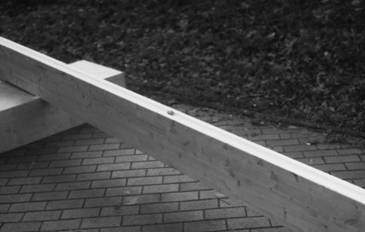 |
||||
The channel was lined with a parchment-like paper to smooth it, the transitions between the pages were smoothed by fine sandpaper. We use brass balls of 20, 25, and 30 mm diameter (fig.3); Galileo did not give the size of the balls he used. |
||||
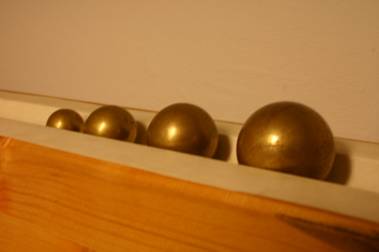 |
||||
Time measurement In the description of his experiment Galileo refers to a method of time measurement called the water clock. In our experiments we use such a device (fig.3). The water clock consists of a 25 l plastic vessel which can be opened and closed at the lower end by the help of a stopcock. Provided that the filling height is sufficient there is a linear relationship between past time and the quantity of water which can be determined by weighing or with the help of a measuring cylinder. A central experimental difficulty is the coordination between the (acoustical?) signal of the running ball and starting and stopping the clock. |
||||
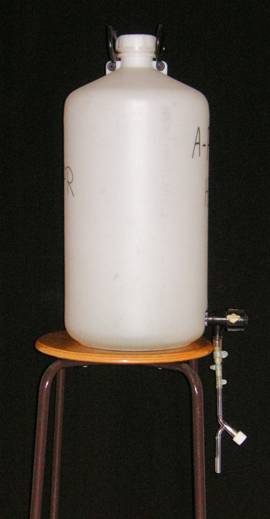 |
||||
We also investigate the method proposed by Stillman Drake (S. Drake, The Role of Music in Galileo’s Experiments, Scientific American 232 (1975), 6, pp. 98-104) where adjustable strings (fig.5) are used to create a steady rhythm which can be compared with the musical rhythm of a lute player. |
||||
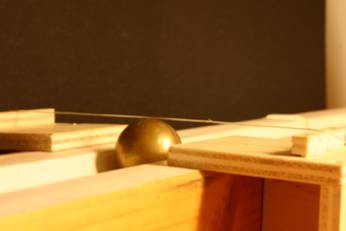 |
||||
| The experiments are performed with different inclination angles of the plane. The analytical expression for the “falling” (i.e. rolling) time of the ball is |
||||
(which was not known to Galileo). |
||||
The next steps
|
||||

